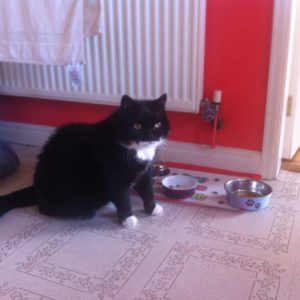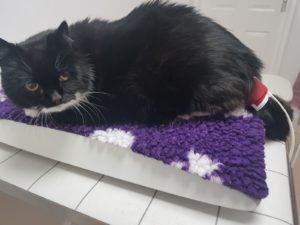Hypertension in Cats
Hypertension is the medical term for high blood pressure and is very common in our ageing veterinary patients. The causes of hypertension in our species are a bit different to humans and vary even between dogs and cats. It is important to recognise and treat hypertension because it can result in reduction of the function of internal organs and reduce our patients’ quality of life.
In cats, kidney disease is the most common cause of hypertension. The kidneys, when functioning normally, act as filters for the by-products of metabolism. They remove components from the blood that at high levels would become toxic. Simultaneously, they regulate salt and water levels in the body. The kidneys need to receive blood at normal pressures to push it through their delicate filtering apparatus. If the pressure is too high, over time, the kidneys become unable to work efficiently. They do have a coping strategy so they are not damaged by normal change in blood pressure that happen on a day-to-day basis. Ultimately however, in kidney disaese, this becomes overwhelmed and the result is worsening kidney function.
Hyperthyroidism is another common cause of hypertension in older cats. The thyroid hormone produced by the thyroid gland in the neck is used to help regulate the body’s rate of metabolism. When too much is produced, it affects how efficiently the muscle of the heart can work and ultimately, it has a toxic effect on this muscle.
Hypertension, regardless of its cause, needs to be managed because as well as further impairing kidney function, the eyes and brain are also vulnerable to insult. These organs are called “end organs” meaning that the blood pressure they need to function must be maintained within a tight range. If hypertension is not controlled, the tiny blood vessels supplying the eyes and brain can burst and cause bleeding there. This may be seen as red patches on the retina at the back of the eye or as red fluid in the chamber at the front. These bleeds cause vision impairment or even complete blindness. Some patients develop seizures as a result of blood vessel damage on the brain.
Obesity is also a known cause of hypertension. It is easy to recognise but not always so simple to control!
 Kasper, a beautiful older cat is a regular at Hollybank and has experienced the symptoms of hypertension and the benefits of treatment. He was first brought in because his observant owners noticed he was bumping into things and had reddish areas in his eyes. Examination with an opthalmoscope revealed patched of bleeding on his retinas. This part of the eye is involved in image-formation so unfortunately, Kasper’s sight is permanently reduced because of this.
Kasper, a beautiful older cat is a regular at Hollybank and has experienced the symptoms of hypertension and the benefits of treatment. He was first brought in because his observant owners noticed he was bumping into things and had reddish areas in his eyes. Examination with an opthalmoscope revealed patched of bleeding on his retinas. This part of the eye is involved in image-formation so unfortunately, Kasper’s sight is permanently reduced because of this.
 Kasper was found to have hypertension and blood and urine tests confirmed our suspicion that a reduction in his kidney function is likely to be the underlying cause. Luckily his thyroid hormone level was normal but he does have a heart murmur which we monitor regularly. Poor Kasper developed seizures as a result of his hypertension but luckily these responded well to treatment.
Kasper was found to have hypertension and blood and urine tests confirmed our suspicion that a reduction in his kidney function is likely to be the underlying cause. Luckily his thyroid hormone level was normal but he does have a heart murmur which we monitor regularly. Poor Kasper developed seizures as a result of his hypertension but luckily these responded well to treatment.
The mainstay of treatment for feline hypertension is a drug called amlodipine. It acts by increasing the efficiency of the cardiovascular system (the heart and blood vessels). Drugs called ACE inhibitors are used if we have evidence that kidney function has reduced to such an extent that too much protein is being lost in the urine. If like Kasper, the presenting symptom is seizures, then medication to help control these may be needed whilst the blood pressure medication takes effect.
 Unfortunately, we will not be able to give Kasper his sight back but his medications will help preserve his remaining kidney function for as long as possible. Since Kasper also struggles with his weight and we know obesity contributes to hypertension, he is now on a prescription weight reduction diet. With the commitment of his dedicated owners, we are delighted to report he is making excellent progress.
Unfortunately, we will not be able to give Kasper his sight back but his medications will help preserve his remaining kidney function for as long as possible. Since Kasper also struggles with his weight and we know obesity contributes to hypertension, he is now on a prescription weight reduction diet. With the commitment of his dedicated owners, we are delighted to report he is making excellent progress.
Kasper will continue to have regular blood pressure checks to ensure he is receiving just the right level of medication. He is a cooperative boy and this has certainly helped in managing his hypertension. The checks are performed by placing an inflatable cuff around Kasper’s tail and the machine measures the pressures at which blood flows in the artery there. The most useful reading the machine gives us is called Mean Arterial Pressure (MAP). Before starting treatment, Kasper’s MAP values were consistently high. With his amlodipine treatment, they gradually decreased and are now within the target range. The process of measuring blood pressure is non-invasive and totally pain-free. It is usually very well tolerated and the nurses are practised at ensuring accurate readings by keeping the room quiet and the patients relaxed- Kasper can vouch for this!
The important thing to remember is that hypertension is a treatable condition and whilst it can’t be cured, our patients’ quality of life is enhanced by controlling it. If you have any questions about hypertension, thyroid or kidney disease or obesity our vets will be happy to address them.

